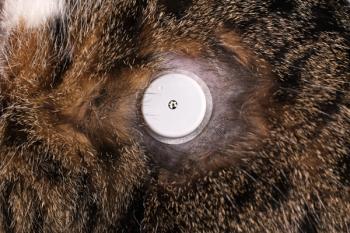
Cushing's disease and other adrenal gland disorders
A Q&A with veterinary endocrinologist Edward C. Feldman
DVM: In your position at the University of California-Davis School of Veterinary Medicine, you have the opportunity to diagnose and treat a large number of adrenal gland disorders in dogs. Is there any new information that may influence our clinical approach to hyperadrenocorticism?
Dr. Edward C. Feldman
Feldman: Most studies agree that the ACTH stimulation test is neither sensitive (about 40 percent of dogs with Cushing's have an abnormal result) nor specific (an abnormal result does not consistently indicate that Cushing's is present). No dog should be treated unless it has obvious and worrisome clinical signs seen by the owner.
DVM: That being said, besides a basic database, which diagnostic test do you prefer to perform first if you suspect Cushing's?
Feldman: The most sensitive and specific tests in the diagnosis of Cushing's in dogs are the history (most important) and physical examination (next most important). The urine cortisol-creatinine ratio is quite sensitive but not specific. The low-dose dexamethasone suppression (LDDS) test is sensitive and relatively specific if the test is performed on dogs with appropriate history and physical examination results. I do not recommend an ACTH stimulation test unless iatrogenic disease is suspected.
DVM: How does the presentation of patients with iatrogenic hyperadrenocorticism differ from other cases of Cushing's disease, and how do you approach diagnosis and treatment in these patients?
Feldman: Iatrogenic and naturally occurring Cushing's are clinically indistinguishable. While the ACTH stimulation test is an inferior screening test for naturally occurring Cushing's, it is the gold standard for the diagnosis of iatrogenic cases. If a dog looks, smells and feels like it has Cushing's and if an iatrogenic source is suspected, an ACTH stimulation test should be performed. Treatment could not be easier: Stop the steroids.
DVM: Could you outline how your treatment recommendations change when you suspect an adrenal tumor as the cause of hyperadrenocorticism?
Feldman: Dogs with a cortisol-secreting adrenal tumor should be treated for eight to 16 weeks with trilostane. The initial dose should be about 0.5 mg/kg twice a day. Then, assuming that good control has been achieved for about eight weeks, surgical removal of the adrenal tumor should be performed. Remember that a large percentage of adrenal masses extend into the vena cava or other major blood vessels, so it is important that the surgeon be experienced in removing such masses.
DVM: So has trilostane become your first choice in the treatment of hyperadrenocorticism, or do you continue to use mitotane (o,p'-DDD)? Is there a particular protocol you use if you switch between the two medications to avoid possible complications, in light of a couple of reported cases of acute adrenocortical necrosis following a switch?
Feldman: Trilostane is my first choice in dogs with an adrenal tumor. My first choice for dogs with pituitary-dependent hyperadrenocorticism is mitotane. However, trilostane at an initial dose of 0.5 mg/kg given twice daily is an excellent second choice. No veterinarian should consider the use of trilostane before thoroughly reading the insert provided with the drug — not the insert for pet owners, the insert for veterinarians. Any dog switched from one to the other should receive no medication for at least six weeks.
Regarding adrenal necrosis: Both mitotane and trilostane have been linked with adrenal necrosis. Mitotane, as a cytotoxic drug, certainly acts by killing cells. Trilostane, however, is the only drug that has been associated with necrosis, adrenal rupture, acute bleeding, related illness and/or death. Therefore, switching from one drug to the other may not be the cause of necrosis or rupture, since this adverse reaction has been demonstrated to occur in dogs that have only received trilostane. Mitotane has not been associated with adrenal rupture.
DVM: Given that there are different causes, diagnostics and treatment options for dogs with Cushing's, are there any areas of client communication that you feel many practitioners could handle better?
Feldman: First, I believe veterinarians are doing a super job in the diagnosis and treatment of Cushing's. Owners should be informed that treatment is elective — Cushing's treatment is rarely, if ever, an emergency. Dogs that are not treated usually have progression of their signs — polydypsia, polyuria, polyphagia, panting, hair loss, pot belly, muscle weakness, thin skin and so on. So if signs are not initially worrisome, give it some time. Also, it is important to let owners of dogs treated with trilostane or mitotane know that both drugs have the potential to cause serious adverse reactions.
DVM: Have you observed any changes in the incidence of Cushing's disease in small animals? For example, are there fewer cases of iatrogenic Cushing's, or are more cases being diagnosed because of better recognition and diagnostic testing by general practitioners?
Feldman: I have not seen any evidence that the incidence has changed. What has changed is a desire on the part of some pharmaceutical companies and some specialists to have more and more dogs diagnosed. This has resulted in more and more dogs being treated for Cushing's that, I believe, do not have Cushing's. The key in deciding which dogs to treat is to only treat dogs with obvious and bothersome clinical signs. To put it another way, a veterinarian should not treat a dog for Cushing's unless he or she would treat it if it were his or her own pet.
DVM: On a slightly different note, for your addisonian patients, after fluid therapy and/or glucocorticoid therapy, do you prefer to use desoxycorticosterone pivalate (DOCP) injections or daily fludrocortisone orally for mineralocorticoid replacement?
Feldman: I prefer using DOCP injections. It is effective and more convenient for clients.
DVM: For cases of Cushing's as well as many other endocrine diseases, long-term treatment can be necessary. Given the tough economic times, clients may be less interested in long-term management of diseases in their pets. How do you educate pet owners about the benefits of diagnostics and long-term management?
Feldman: Well, your question is the answer. The key is to educate owners so that they understand the benefits and risks of either choosing to treat or not to treat.
DVM: Finally, do you have any advice for veterinarians with an interest in expanding their practice's ability to diagnose and manage endocrine disorders?
Feldman: Read journals, attend quality lectures and have in-depth discussions with specialists on cases. Some wonder if they can trust the opinion of a lecturer. Trustworthy speakers are those who publish in peer-reviewed, high-quality journals. Such speakers have had their opinions exposed to peer review, and, thus, their opinions have been "assessed" by folks whose knowledge is respected. Regarding trilostane, I would suggest that interested veterinarians read our 2008 paper in JAVMA and be on the lookout for a second paper on trilostane that will also appear in JAVMA later this year.
DVM: Thank you very much, Dr. Feldman. The information you have provided today about Cushing's disease points us toward better diagnostic and treatment decisions and may encourage many veterinarians to step back and evaluate the need for treatment at all. And all of us can benefit from the reminder to do a better job of addressing continuing education on a regular basis.
Editor's Note: Edward C. Feldman, DVM, Dipl. ACVIM, is the chair of the Department of Medicine and Epidemiology at the University of California-Davis School of Veterinary Medicine. He is a co-founder and former president of the Society of Comparative Endocrinology, a special interest group open to all veterinarians, and is a co-author of the Textbook of Veterinary Internal Medicine with Dr. Stephen Ettinger and Canine and Feline Endocrinology and Reproduction with Dr. Richard Nelson.
Dr. Blake is a freelance technical editor and writer in Eudora, Kan.
Newsletter
From exam room tips to practice management insights, get trusted veterinary news delivered straight to your inbox—subscribe to dvm360.




